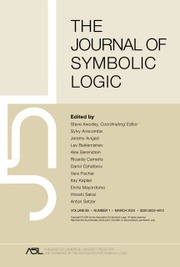Crossref Citations
This article has been cited by the following publications. This list is generated based on data provided by Crossref.
Itzkowitz, Gerald L.
1998.
Cardinal numbers associated with dense pseudocompact, countably compact, and ω-bounded subgroups.
Topology and its Applications,
Vol. 84,
Issue. 1-3,
p.
21.
Salonen, Hannu
2001.
On Completeness of Knowledge Models.
SSRN Electronic Journal ,

